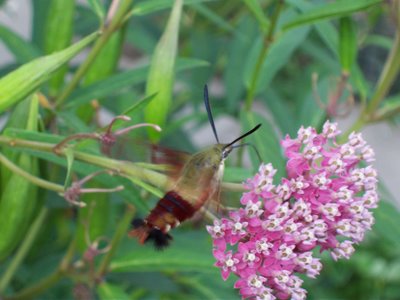

I guess blogging about my arthropod-filled composter, my hidous cache of compost on the kitchen counter, and the bugs on our swamp milkweed brought a whole new genre of Google searchers to my blog. "Bagworm and revolution", "found earwigs in my kitchen", and "tiny maggots" have replaced "fat housewife blogger" and "housewife 1 on 1" as the most recent keywords that Google has directed here. Maybe that's an improvement, although I'm really wondering about bagworms and their revolution. Evolution, yes, but revolution? I don't even want to think about the bagworm revolution. And except for a few earwigs that came in nestled into some flowers (quickly removed), we don't have earwigs in our kitchen.
Meanwhile, our swamp milkweed (aka rose silkweed, flesh-colored milkweed, rabbit milk, rose milkweed, silkplant, swamp silkweed, water nerve root, and white Indian hemp - so called because its fiber was used by several Native American groups - check out Dan Moerman's wonderful database here) is attracting hordes of butterflies: monarchs every time I look, tiger swallowtails, some giant black butterfly with orange and blue on the outside of its wing that may be a black swallowtail. The most interesting nectar-sipper we've noticed in the last few days has been a giant hummingbird moth. It is almost as large as a hummingbird (which we also have, but they seem to prefer the jewelweed and the hummingbird feeders).
It looks like ours is the hummingbird clearwing moth, or Hemaris thysbe, which is a type of sphinx or hawkmoth. I had no idea that this is the kind of creature that comes from those disgusting hornworms.
No comments:
Post a Comment